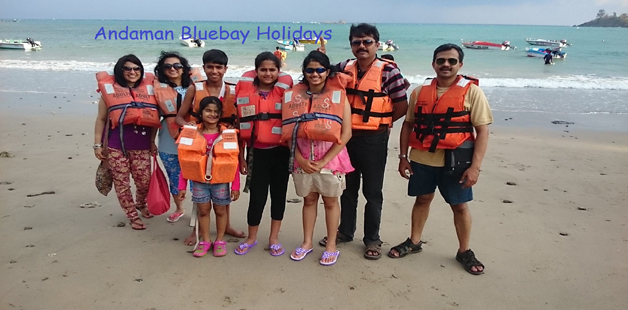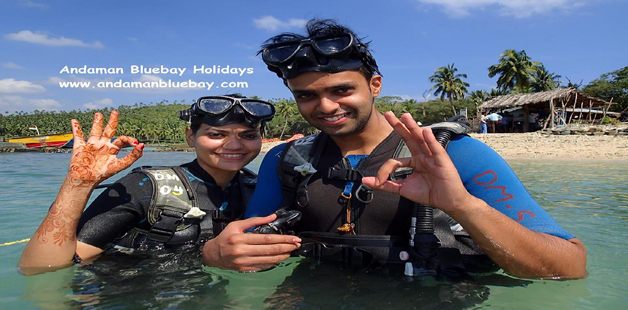TRIBALS OF ANDAMAN & NICOBAR ISLANDS
The Andaman and Nicobar Islands is home to 4 Negrito and 2 Mongoloid tribes. Those belonging to the Negrito origin – the Great Andamanese, the Onge, the Jarawas and the Sentinelese - are still at hunting-gathering stage of economy. The Mongoloid origin, Nicobarese, has accepted the challenge of change and have prospered and multiplied. The members of the other Mongoloid community, the Shompen, still shy away from outsiders.
The Jarawa, Onge, Sentinelese and Great Andamanese are thought to have travelled to the Andaman Islands from Africa up to 60,000 years ago. The Andaman & Nicobar Islands remained the abode of the Negritos and the Mongoloids, who occupied the Islands for centuries.
The first tribe to come into contact with the Indian settlers were the Great Andamanese followed by the Onge and finally the Jarawa. Barring Sentinelese, other tribes have come into contact with the Indian settlers.
GREAT ANDAMANESE
In the mid 19th century when the British established the penal settlement in the Andamans it was estimated that there were at least 5000 members of the Great Andamanese Community. In just a century and a half the population of that community has come down to about 50 individuals. Hundreds of Great Andamanese were killed in conflicts with British settlers, as the tribe defended their territory from invasion.
By the turn of the 20th century the various linguistic and tribal divisions among the Great Andamanese effectively ceased to exist. Their linguistic diversity also suffered as the surviving populations intermingled, and some of them intermarried with Burmese and Indian settlers. By the latter part of the 20th century the majority of Great Andamanese languages had become extinct.
In 1970, all Great Andamanese were re-settled in Strait Island, a short distance from Port Blair by the Indian government, where they are now totally dependent on the government for food, shelter and clothing.
ONGE
Onge, who lived in two separate reserves in Little Andaman, i.e. Hut Bay and Dugong Creek, have recently moved further interior to the forest after Tsunami killer waves attacked the Island.
With a hope to increase its population, Primitive Onge tribals who consider remarriage a taboo, have for the first time agreed to remarry . The number of members have drastically fallen to 94. It is hoped that Remarriages would take place among Onges, & it would save them from extinction.
The Onges were devastated following British occupation of the Andaman Islands in the 19th Century. From a population of 672 in 1901, the tribe has been reduced to 94 -- 24 men, 32 women, 23 boys and 15 girls.
JARWAA
Very little is known about the Jarawas, apart from the fact that they use rafts, live in oval huts and are excellent swimmers. The Jarawas, approximately 320 in number, live in the thick forests of the Middle Andaman, were totally isolated from the outside world till very late.
In the history of the Andamans for the first time on Oct 21, 1997, 8 Jarawas, 4 of them women, emerged from the jungle close to Kadamtala in Middle Andaman. Signalling for food, they pointed to their bellies. They were fed bananas and coconuts and sent back by villagers who were petrified lest the Jarawas let loose their arrows. This, however, triggered a regular arrival of Jarawas to nearby villages.
As the population of Jarawas have dwindled, Settlers and poachers have pillaged the forests. The word Jarawa is a term neighbouring tribes use for them. It means "the other people". While anthropologists have so far been unable to decipher the language of the Jarawas or its origin, the tribesmen have now picked up Hindi and other languages through their contact with people outside their forest home.
SENTINELESE
The isolated tribe called Sentinalese live in Sentinel Island. The Sentinelese are one of the world's last Stone Age tribes. The Sentinelese, thought to number between 50 and 200, have rebuffed all contact with the modern world & fire a shower of arrows at anyone who comes nearby. They are believed to be the last pre-Neolithic tribe in the world to remain isolated and appear to have survived the 2004 Asian Tsunami.
Environmental groups urged the authorities to leave the bodies and respect the 5-kilometre exclusion zone thrown around the island. In the 1980s and early 1990s many Sentinelese were killed in skirmishes with armed salvage operators who visited the island after a shipwreck. Since then the tribesmen have remained virtually undisturbed.
NICOBARESE
The Nicobarese mainly live in Car Nicobar. The population of Nicobarese is in Thousands prompting the Indian government even to launch a Population control program among them. The 30,000-strong Nicobarese suffered the most due to the killer waves of Tsunami in December, 2004.
The Nicobarese are mainly horticulturist and pig-herders inhabiting large permanent villages mostly close to sea shore. They are not divisible into tribes, but there are distinctions, chiefly territorial. Nicobarese families are patriarchal and as a rule live jointly. This joint family is known as Tuhet. There is no individual ownership, but the Tuhet owns land, coconut and pigs. Love marriage is very common and the age of marriage is sufficiently high.
SHOMPEN
The Shompens are hunter-gatherers who have only very limited contact with outsiders. Their population in the last census of 2001 was only 398.
Shompen is one of the “most isolated and poorly understood” contemporary hunter and gatherer tribe that inhabits the Nicobar Islands. They live in about 12 habitations made of bamboo and leaf thatch. The Indian Government has initiated efforts for the protection of the fast-depleting Shompen primitive tribe in the Nicobar islands and proposed granting it the status of “unique human heritage” of the country.
The Primitive tribals of the Andaman and Nicobar Islands are dying of disease and infection brought by waves of colonizers from the Indian mainland. The Indian government's grand plan to bring the Andamans on India's tourist circuit could sound the death knell for tribals of the region.
The archipelago in the Bay of Bengal, which has played home to the 6 tribal groups for about 20,000 years, is proposed to become a "selective" tourist destination as per the tourism policy envisaged for the Andaman and Nicobar Islands.
The high-value, low-volume tourism potential of the region notwithstanding, experts fear the cost of development will have to be borne by these aboriginals. The past 150 years have seen the tribals become a victim of exploitation, first by the British and then later, by the local administration, by its lackadaisical approach to their welfare. Slowly and silently, the Indian government's efforts to bring the tribals to the mainstream have only resulted in their numbers getting diminished with each passing year. The government's efforts over many decades to 'tame and civilize the tribals and bring them into the mainstream' have rather resulted in hurting them.
Experts say the tribals in the archipelago have been on the wrong side of most of the development plans drawn for the region so far. The government sees the proposed tourism plan fuelling development in the region.



















